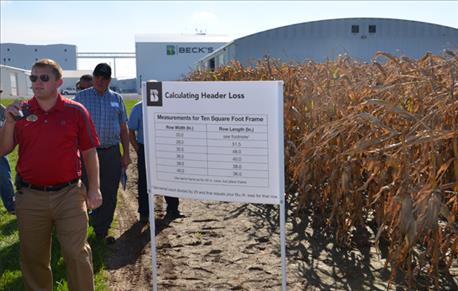September 9, 2016

A recent field day may have been many people's first look at a multidirectional corn head that can be used to harvest corn planted at varying row widths, or even multiple row widths, in the same pass. It may not be a widespread practice now, but it’s one some people are exploring for the future.
Capello supplied a corn head that Beck’s could demonstrate. Since the field day occurred before most corn was ready, they only ran a small plot that had been sprayed to help the crop dry down faster. Therefore, there's no information on header loss for this machine compared to conventional machines yet. However, Beck's intends to use the new header to harvest certain plots in its Practical Farm Research studies.
Seeing a video of the new concept-head work on the small plot was exciting. But even farmers who immediately thought this would never apply to them because they could never afford to buy such a head could take a basic lesson home from this field day stop.
Header loss matters
Michael Baird of Beck’s discussed why knowing how much you are leaving behind from header loss is important. Header loss is only one component of total field loss. There is also the possibility of losing kernels out the back of the combine.
Baird outlined how to count header loss, based on a method established by university researchers. He also pointed to frames that he and other assistants used to count loss after running the header.
Here are the four simple steps. This method is based on information released by University of Georgia Extension engineers Paul Sumner and Jay Williams.

SHOOT FOR LESS LOSS: Michael Baird of Beck’s says one reason they tried the new multidirectional corn head from Capello on PFR plots was to see if it reduced header loss in certain situations.
SHOOT FOR LESS LOSS: Michael Baird of Beck’s says one reason they tried the new multidirectional corn head from Capello on PFR plots was to see if it reduced header loss in certain situations.
Step 1. Remove residue and lay out a 10-square-foot rectangle over the row. Carefully removing corn residue from each row makes it much easier to find any kernels that were lost at the header. This step assumes you ran the combine, then backed up and checked for loss over each row in front of the combine. Any loss you find is only from the header.
Step 2. Determine appropriate row length to measure and count kernels. If you are in 30-inch rows, use a 30-by-48-inch frame. That’s 10 square feet. Lay it over the center of each row.
Step 3. Do the math to determine header loss. The Georgia engineers discovered that 24 kernels in 10 square feet equate to 1.2 bushels per acre. Use the frame and count kernels found in each row. Average the loss across the rows to determine header loss.
Step 4. Account for ear loss at the header. Count the number of whole ears lost in 1/100 of an acre. In 30-inch rows, look for ears in 174 feet. Each three-quarter-pound ear or equivalent left behind equals 1 bushel per acre of loss.
You May Also Like




